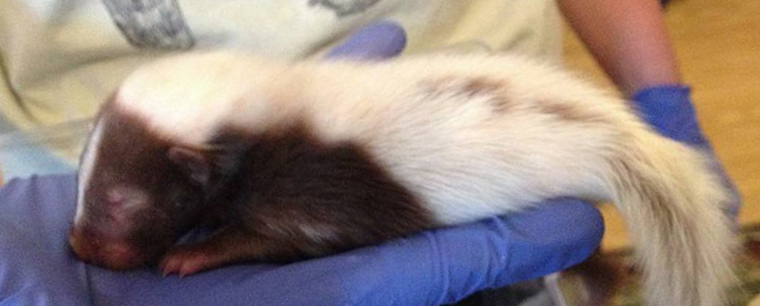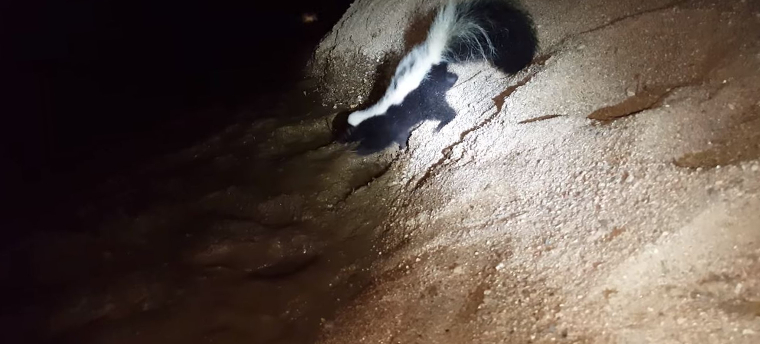-
info@aaanimalcontrol.com
Call us for help in your town
Humane Wildlife Education
Reason why skunks have white stripes
Need skunk removal in your hometown? We service over 500 USA locations! Click here to hire us in your town and check prices - updated for year 2020.
There are few species in the animal kingdom that are as distinctive as the skunk, and certainly for the Striped Skunk with its broad stripe is an animal that can be spotted from quite some distance. While in some cases nature may produce an aberration, this certainly isn’t the case with the skunk, as the white stripes on the animals are definitely there for a practical reason. The answers to these questions are found in the evolution of the species, and have effectively developed as a way to help the species become more effective at surviving and thriving.

The Differences In Skunk Markings
While most people will think that all skunks will have the distinctive white stripes running down their back, there are actually several different skunk species to be found in North America, and not all of these actually do have a white stripe. Indeed, the most common skunk species is the Striped Skunk, which as the name suggests has the distinctive white stripe, and this is the most common skunk species in the United States. Another species is the spotted skunk, and as the name suggests this can have a dappled or swirled effect in the black and white fur, while the hooded skunk has a white hood and an almost entirely white back, with only black fur on the underside.
Evolution Of The Skunk’s Stripe
Like any other form of evolution, at some point in the development of the species one or more of the skunk’s ancestors will have developed the white stripe, and they would have then found that this development helped with the survival of the species. As those with the stripe would have become more successful at surviving, then the species would have found more of those skunks with stripes breeding with each other, and these genes would turn from an aberration into a dominant gene for the species.
The Purpose Of The Skunk’s Stripe
Like all animals, the evolution of skunks has largely been dictated by the features in the animal that has helped the skunks to survive and to thrive. Self-defense is something that can work in many different ways, and in the case of the skunk species, the purpose of the stripe is to warn other animals including potential predators that this is a skunk, and you shouldn’t try to attack it.
The reason for this is that along with the stripe, the skunk’s other self-defense mechanism is the fact that it has a scented musk which is utterly repulsive to almost every species that comes into contact with it. While some species use their markings as camouflage in self-defense, for the skunk their markings are a warning to other animals that if they come too close, they may get sprayed by this horrible smell.
Dealing With Problem Skunks
While skunks are a species that can live happily in the wild, when they find their way into urban or suburban areas, then skunks can cause significant problems as they scavenge for food and even make their nests in areas around domestic properties. The best way to get rid of the animals is by using a cage trap to catch the skunk, and then to transport it to a rural area well away from your property or where the skunk was causing the problem. While there are other solutions to deal with the problem too, if you are worried about being sprayed by the animal, one alternative is to hire a professional animal removal expert who will also be able to deal with the skunk on your behalf.
Do skunks shed their fur?
Need skunk removal in your hometown? We service over 500 USA locations! Click here to hire us in your town and check prices- updated for year 2020.
You wouldn't normally think of skunks shedding their fur, but just like other fur-covered animals, they do. They actually shed their fur twice yearly, letting the coarse and long hair fall away in the spring that they develop in fall for winter, and then shedding the downy-like, softer hair towards the end of the warmer, spring months. It doesn't last for very long — these shedding periods — and usually less than the time it takes for a cat or dog to shed. You will find that not a lot of hair is shed too. These animals are smaller than your average cat or dog, therefore, will not shed quite as much hair as those two domesticated animals.

The reason for this shedding action is very similar to that of cats and dogs. They need long and thick hair during the winter in order to keep themselves warm, but this would cause them to soon overheat during the warmer month of the year. They shed this thicker fur for a lighter, softer version of it, keeping them cool during the spring. Once spring and summer is over, the weather starts to turn cooler again, and the skunk will grow back the thicker, coarse hair to start the cycle all over again.
For more information, you may want to click on one of these guides that I wrote:
How much does skunk removal cost? - get the lowdown on prices.
How to get rid of skunks - my main skunk removal info guide.


















